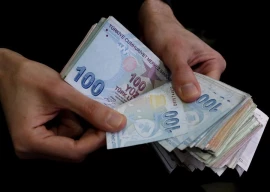
Fitch Ratings has downgraded Pakistan's long-term foreign-currency issuer default rating (IDR) to 'CCC+' from 'B-' on the day the Asian Development Bank (ADB) approved financing of $1.5 billion for the country and the Financial Action Task Force (FATF) upgraded Islamabad to its white-list from the grey one.
“The downgrade reflects further deterioration in Pakistan's external liquidity and funding conditions, and the decline of foreign-exchange reserves," the global rating agency said in an announcement on Friday.
"Fitch typically does not assign outlooks to sovereigns with a rating of 'CCC+' or below,” it added.
The FATF’s decision to having relocated Islamabad to white-list is expected improve foreign currency inflows including from investors abroad.
Fitch announced its latest rating action following Moody's Investors Service downgrading Pakistan's credit rating to 'Caa1' from 'B3' some two weeks ago.
Finance Minister Ishaq Dar and his team had found the decision “unilateral” and said the verdict was based on “incomplete information”.
Dar and his team had updated that Pakistan was under the International Monetary Fund (IMF) loan programme, while the country had full arrangements worth around $36-40 billion to repay foreign debt, finance current account deficit (CAD) and boost foreign exchange reserves in FY23.
However, both the rating agencies ignored the developments in the offing.
Fitch said Pakistan's debt-to-GDP ratio was 73% at FY22, broadly in line with the current 'B' median.
"We expect debt/GDP to fall to 70% in FY23 and continue decreasing, helped by high inflation and a modest primary deficit," the rating agency added.
It forecasted the country ‘s CAD to narrow to $10 billion [2.7% of GDP] in FY23, despite the hit to export revenue and import needs after the recent floods.
Fitch elaborated that its decision was partly a result of widespread floods, which would undermine Pakistan's efforts to rein in the twin fiscal and current account deficits.
"The downgrade also reflects our view of increased risks of policies potentially undermining Pakistan's IMF programme and official financial support,” the Fitch statement read.
Pakistan's external public debt maturities in FY23 are over $21 billion, mostly to bilateral and multilateral creditors, "which mitigates rollover risks, and there are already agreements to roll over some of these."
“The reserves have depleted to $7.6 billion in the week ended October 14, 2022 that are equivalent to slightly over one-month import payment and debt repayments. They stood at $20 billion at end-August 2021,” it said.
The rating agency said Pakistan had recently received funding commitments of $2.5 billion from the World Bank and ADB, according to the authorities, although it understood that much of this was repurposed from the ongoing programmes.
"It remains unclear to what degree the IMF will be able to relax Pakistan's programme targets, or augment [the country’s] access under the EFF [Extended Fund Facility],” the statement read.
Fitch assumed Pakistan would continue to receive disbursements under its IMF programme, but risks to this had risen.
"Fuel-price cuts [in local markets] from October 1, 2022 may not be compatible with commitments to the IMF. A quarterly electricity tariff adjustment due in October has yet to happen,” Fitch added.
The new finance minister has reaffirmed commitment to the programme, but prefers a "strong exchange rate, and may revisit the SBP law that was amended in early 2022 to grant the [central bank] greater autonomy, as previously agreed with the IMF," Fitch said in support of its decision to revise down the country's credit rating.
It also expected the country's fiscal deficit to narrow down to 6.2% of GDP (about Rs5 trillion or $23 billion) in FY23, driven by some spending restraint and higher taxes compared to 7.9% of GDP (over Rs5 trillion) in FY22.
Fitch said it saw gross domestic product (GDP) growth to decelerate to about 2% in FY23, from 6% in FY22, "amid fiscal and monetary tightening, high imported inflation, a weak external demand outlook, and flood-related disruptions."
This is broadly in line with the government's forecast, down from its initial target of 5% and a 3.5% forecast in the IMF programme.
The 2010-2011 floods contributed to Pakistan's weak recovery after the global financial crisis.
The authorities estimate the flood damage at $10 billion-30 billion, but reconstruction costs are likely to be lower, as is the impact on Pakistan's twin deficits.
The rating agency said the increasing political instability which might result into policy slippages once the ongoing IMF programme worth $6.5 billion ended in June 2023.
It said former prime minister Imran Khan, who was ousted in a no-confidence vote on April 10, continued to put political pressure on the government, organising protests across the country calling for early elections.
Imran’s party, the PTI, won the by-elections in the key Punjab province in July, defeating the incumbent PML-N.
The PTI secured more national and provincial seats in the by-elections on October 17.
“Regular elections are due in October 2023, creating the risk of policy slippage after the conclusion of the IMF programme due in June,” Fitch noted.









1730379446-0/WhatsApp-Image-2024-10-31-at-17-56-13-(1)1730379446-0-270x192.webp)
1724926799-0/Untitled-design-(7)1724926799-0-270x192.webp)









COMMENTS
Comments are moderated and generally will be posted if they are on-topic and not abusive.
For more information, please see our Comments FAQ